Development and Performance Study of a Slow-Releasing Anti-Icing Fog Seal Based on Response Surface Methodology
Abstract
1. Introduction
2. Materials and Methods
2.1. Raw Material
2.1.1. Waterborne Epoxy-Modified Emulsified Asphalt
2.1.2. Slow-Release Anti-Icing Agent
2.2. Slow-Release Anti-Icing Fog Seal Material Preparation
2.2.1. Preparation Process
2.2.2. Single-Factor Determination of Component Range
- (1)
- The dosage of slow-release anti-icing material:
- (2)
- The dosage of water-based epoxy resin modifier:
- (3)
- Penetrant dosage:
2.2.3. Response Surface Experiment
2.2.4. Ice-Melting Performance Test
2.2.5. Ice–Road Surface Adhesion Strength Test
2.2.6. Permeability Test
2.3. The Performance Evaluation of Slow-Release Anti-Icing Fog Seal
2.3.1. Abrasion Resistance Test
2.3.2. Skid Resistance Test
3. Results and Analysis
3.1. Analysis of Single-Factor Experimental Results
3.1.1. The Effect of Slow-Release Anti-Icing Agent
3.1.2. The Effect of Waterborne Epoxy Resin Modifier
3.1.3. The Effect of Permeating Agent
3.2. Response Surface Method Analysis
3.2.1. Response Surface Model Fitting Analysis
3.2.2. Optimization of Slow-Release Anti-Icing Fog Seal Formulation
3.3. Analysis of the Abrasion Resistance of Slow-Release Anti-Icing Fog Seal
3.4. Analysis of the Skid Resistance of Slow-Release Anti-Icing Fog Seal
4. Conclusions
- Single-factor optimization determined that the optimal dosage ranges for slow-release anti-icing material, waterborne epoxy resin modifier, and permeating agent were 10%–15%, 10%–20%, and 9%–15%, respectively.
- The ratio of the various components of the slow-release anti-icing fog seal was optimized based on the response surface method, with the ice-melting performance, ice–road surface adhesion strength, and permeation properties as the response indicators, and the final optimal ratio of the slow-release anti-icing fog seal was determined: the slow-release anti-icing material dosage was 13%, the waterborne epoxy resin modifier dosage was 20%, and the permeating agent dosage was 12%.
- The wear resistance of the slow-release anti-icing fog seal decreased most significantly during the initial stages of accelerated loading, with alkaline basalt particles proving most effective in enhancing wear resistance.
- Initially, the anti-icing fog seal met the skid resistance and texture depth standards specified in JTG D50-2017 for asphalt pavements. However, surface roughness and texture depth gradually decreased due to the spalling of abrasion-resistant particles, followed by accelerated smoothness loss, contributing to further declines in pendulum value and texture depth.
Author Contributions
Funding
Institutional Review Board Statement
Informed Consent Statement
Data Availability Statement
Acknowledgments
Conflicts of Interest
References
- Editorial Department of China Journal of Highway and Transport. Review on China’s Pavement Engineering Research: 2024. China J. Highw. Transp. 2024, 37, 1–81. (In Chinese) [Google Scholar] [CrossRef]
- Lawlor, M.; Hossain, K. An investigation on the deicing potential of road salt and alternative deicers. Can. J. Civ. Eng. 2024, 51, 874–885. [Google Scholar] [CrossRef]
- Hinkka, V.; Pilli-Sihvola, E.; Mantsinen, H.; Leviäkangas, P.; Aapaoja, A.; Hautala, R. Integrated winter road maintenance management—New directions for cold regions research. Cold Reg. Sci. Technol. 2016, 121, 108–117. [Google Scholar] [CrossRef]
- Peng, B.; Cai, Q.; Shi, X.; Yan, J.; Xu, M.; Wang, M.; Shi, Z.; Niu, Z.; Guo, X.; Yang, Y. Metal-containing nanoparticles in road dust from a Chinese megacity over the last decade: Spatiotemporal variation and driving factors. J. Hazard. Mater. 2024, 476, 134970. [Google Scholar] [CrossRef]
- Vignisdottir, H.R.; Ebrahimi, B.; Booto, G.K.; O’Born, R.; Brattebø, R.; Wallbaum, H.; Bohne, R.A. A review of environmental impacts of winter road maintenance. Cold Reg. Sci. Technol. 2019, 158, 143–153. [Google Scholar] [CrossRef]
- Zhong, K.; Sun, M.; Chang, R. Performance evaluation of high-elastic/salt-storage asphalt mixture modified with Mafilon and rubber particles. Constr. Build. Mater. 2018, 193, 153–161. [Google Scholar] [CrossRef]
- Huang, G.; Zhang, J.; Wang, Q.; Song, C.; Guo, F.; He, h.; Xu, Z.; He, Y.; Zhang, H.; Falchetto, A.C. Preparation, performance evaluation and de-icing longevity prediction of novel de-icing fiber permeable asphalt mixture. Constr. Build. Mater. 2023, 404, 133198. [Google Scholar] [CrossRef]
- Yin, Y.; Han, S.; Zhu, Y.; Wu, S. Functional durability evaluation of asphalt mixture containing ecologically friendly hydrophobic anti-icing additives. Constr. Build. Mater. 2023, 367, 129781. [Google Scholar] [CrossRef]
- He, Z.; Xu, H.; Zhou, Y.; Tan, Y. Preparation and multi-evaluation of durability for superhydrophobic anti-icing coating on asphalt pavement. Constr. Build. Mater. 2024, 441, 137587. [Google Scholar] [CrossRef]
- Nalbandian, K.M.; Carpio, M.; Gonzalez, A. Assessment of the sustainability of asphalt pavement maintenance using the microwave heating self-healing technique. J. Clean. Prod. 2022, 365, 132859. [Google Scholar] [CrossRef]
- He, Y.; Li, Y.; Wang, Y.; Brooks, A.L.; Polaczyk, P.; Huang, B.; Zhou, H. Coal-derived conductive pavement for winter de-icing: Prototype, modeling, and simulation. Appl. Therm. Eng. 2024, 249, 123356. [Google Scholar] [CrossRef]
- Sun, Y.; Zheng, L.; Cheng, Y.; Chi, F.; Liu, K.; Zhu, T. Research on maintenance equipment and maintenance technology of steel fiber modified asphalt pavement with microwave heating. Case Stud. Constr. Mater. 2023, 18, e01965. [Google Scholar] [CrossRef]
- Liu, K.; Zhang, H.; Da, Y.; Wang, F.; Liu, Q. Regulatory strategy for balancing deicing efficiency and energy-saving effects of induction heating asphalt pavements. J. Clean. Prod. 2024, 466, 142812. [Google Scholar] [CrossRef]
- Deng, Z.; Li, W.; Dong, W.; Sun, Z.; Kodikara, J.; Sheng, D. Multifunctional asphalt concrete pavement toward smart transport infrastructure: Design, performance and perspective. Compos. Part B Eng. 2023, 265, 110937. [Google Scholar] [CrossRef]
- Wu, L.; Liu, Q.; Tang, N.; Wang, X.; Gao, L.; Wang, Q.; Lv, G.; Hu, L. Development of two-dimensional nano Mts/SA phase change materials for self-adjusting temperature of pavement. Constr. Build. Mater. 2022, 349, 128753. [Google Scholar] [CrossRef]
- Meng, Y.; Meng, F.; Chen, J.; Wang, Z.; Li, J.; Deng, S.; Wei, X.; Gou, C. Preparation of slow-release biologically active anti-icing filler and study on the anti-icing long-lasting performance. Constr. Build. Mater. 2024, 416, 135150. [Google Scholar] [CrossRef]
- Zheng, M.; Wang, C.; Han, L.; Sun, J.; Li, Y.; Ma, Z. Laboratory evaluation of long-term anti-icing performance and moisture susceptibility of chloride-based asphalt mixture. Int. J. Pavement Res. Technol. 2016, 9, 140–148. [Google Scholar] [CrossRef]
- Zou, G.; Chen, Q.; Zhang, Y.; Zhang, D.; Yu, J. Research on deicing performance and environmental impact of anti-freezing asphalt mixtures. Constr. Build. Mater. 2024, 428, 136355. [Google Scholar] [CrossRef]
- Zhang, Y.; Shi, X. Laboratory evaluation of a sustainable additive for anti-icing asphalt. Cold Reg. Sci. Technol. 2021, 189, 103338. [Google Scholar] [CrossRef]
- Zheng, M.; Zhou, J.; Wu, S.; Yuan, H.; Meng, J. Evaluation of long-term performance of anti-icing asphalt pavement. Constr. Build. Mater. 2015, 84, 277–283. [Google Scholar] [CrossRef]
- Li, P.; Xiao, X.; Peng, W.; Kong, L.; Liu, Z.; Mao, J.; Han, Y. Performance test and evaluation index recommendation of fog seal on airport asphalt pavement. Case Stud. Constr. Mater. 2023, 19, e02604. [Google Scholar] [CrossRef]
- Zhan, Y.; Luo, Z.; Lin, X.; Nie, Z.; Deng, Q.; Qui, Y.; Wang, T. Pavement preventive maintenance decision-making for high antiwear and optimized skid resistance performance. Constr. Build. Mater. 2023, 400, 132757. [Google Scholar] [CrossRef]
- Duan, M. Development and Performance Evaluation of 3DOM TiO2 Fog Seal Material. Master’s Thesis, Beijing University of Civil Engineering and Architecture, Beijing, China, 2021. [Google Scholar] [CrossRef]
- Sheng, X. Experimental Study on Performance of Sand-Mist Seal on Asphalt Pavement with Self-Healing Function. Master’s Thesis, Nanjing Forestry University, Nanjing, China, 2019. [Google Scholar] [CrossRef]
- Meng, D. Design and Performance Evaluation of Anti-Icing Fog Seal. Master’s Thesis, Harbin Institute of Technology, Harbin, China, 2016. [Google Scholar]
- Zhu, J. Mechanism Analysis and Material Design Research on Anti-Freezing Fog Seal of Asphalt Pavement. Master’s Thesis, Guangxi University, Nanning, China, 2017. [Google Scholar]
- Yao, Y.; Chen, T.; Xiang, H.; Wang, B.; Jiang, S. Experiment of active deicing and snow melting pavement coating with environmental friendly and long-term action. J. Traffic Transp. Eng. 2013, 13, 8–15. [Google Scholar] [CrossRef]
- Lei, J.; Zheng, N.; Chen, Z. Preparation and Research on Performance of Ice-Snow Melting Coating. Highway 2019, 64, 256–261. (In Chinese) [Google Scholar]
- Zhu, J.; Huang, J.; Zhao, Q.; Ling, L.; Qin, Y.; Xi, C.; Meng, Y. Study on slow-release mechanism of salt-storage anti-icing fog seal. Constr. Build. Mater. 2022, 349, 128724. [Google Scholar] [CrossRef]
- Li, J.; Hou, Y.; Deng, W.; He, L. Influence of epoxy content on property of emulsified asphalt cold mix. New Chem. Mater. 2020, 48, 226–230. (In Chinese) [Google Scholar] [CrossRef]
- Feng, Y.; Luo, Y.; Gao, J.; Guo, P.; Jiang, Y.; Liu, F. Preparation and application of a novel slow-releasing with core-shell deicer in asphalt mixtures. Polymers 2022, 14, 2615. [Google Scholar] [CrossRef] [PubMed]
- JT/T 1210.2-2018; Ice and Snow Melting Materials for Highway Asphalt Mixtures Part 2: Salt Materials. China Communications Press: Beijing, China, 2018.
- Zhang, L.; Wang, Y.; Liu, Y.; Lv, S.; Wang, R.; Hu, X.; Liu, Y.; Dong, Z.; Lin, K.; Liu, L. Chloride removal from sewage using bismuth trioxide: Characterization and optimization by response surface methodology (RSM). J. Environ. Chem. Eng. 2023, 11, 110868. [Google Scholar] [CrossRef]
- Dahmane, S.A.; Azzedine, A.; Megueni, A.; Slimane, A. Quantitative and qualitative study of methods for solving the kinematic problem of a planar parallel manipulator based on precision error optimization. Int. J. Interact. Des. Manuf. 2018, 13, 567–595. [Google Scholar] [CrossRef]
- Ma, T.; Geng, L.; Ding, X.; Zhang, D.; Huang, X. Experimental study of deicing asphalt mixture with anti-icing additives. Constr. Build. Mater. 2016, 127, 653–662. [Google Scholar] [CrossRef]
- Li, Y.; Sha, A.; Wang, Z.; Liu, Z. Laboratory measurement of the adhesion strength between asphalt concrete and ice layer. Constr. Build. Mater. 2024, 416, 135102. [Google Scholar] [CrossRef]
- Song, W.; Huang, B.; Shu, X.; Chandler, M.; Woods, M.; Jia, X. Laboratory investigation of fog-seal treatment on performance of open-graded friction course pavement. J. Mater. Civ. Eng. 2021, 33, 04021002. [Google Scholar] [CrossRef]
- JTG/T 3450-2019; Field Testing Procedures for Highway Subgrade and Pavement. China Communications Press: Beijing, China, 2019.
- Zuo, Z.; Fan, Z.; Ding, L.; Chen, Q.; Wang, C.; Li, Y.; Tan, S. Targeted synthesis, macroscopic and microscopic evaluation of permeability performance of a new high-permeability fog seal. Measurement 2024, 236, 115115. [Google Scholar] [CrossRef]
- Wang, Y.; Chen, J.; Yan, Q.; Peng, Y.; Kong, L. Quantitative characterization of aggregates and their chemical constituents in terms of acid and alkaline indicators. Case Studies in Construction Materials 2023, 18, e02079. [Google Scholar] [CrossRef]
- JTG D50-2017; Specification for Design of Highway Asphalt Pavement. China Communications Press: Beijing, China, 2017.
- CJJ/T 190-2012; Technical Specification for Permeable Asphalt Pavement. China Communications Press: Beijing, China, 2012.

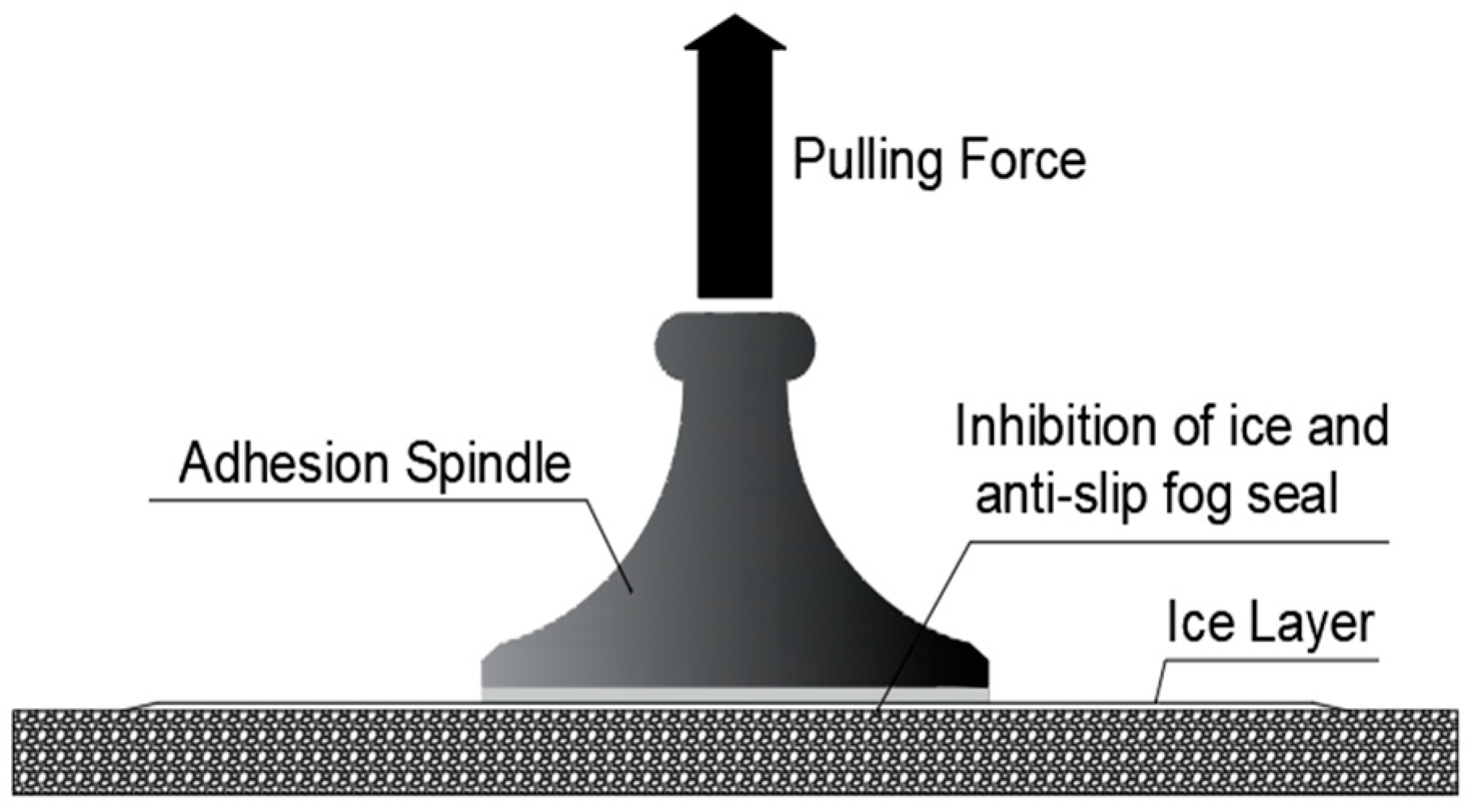
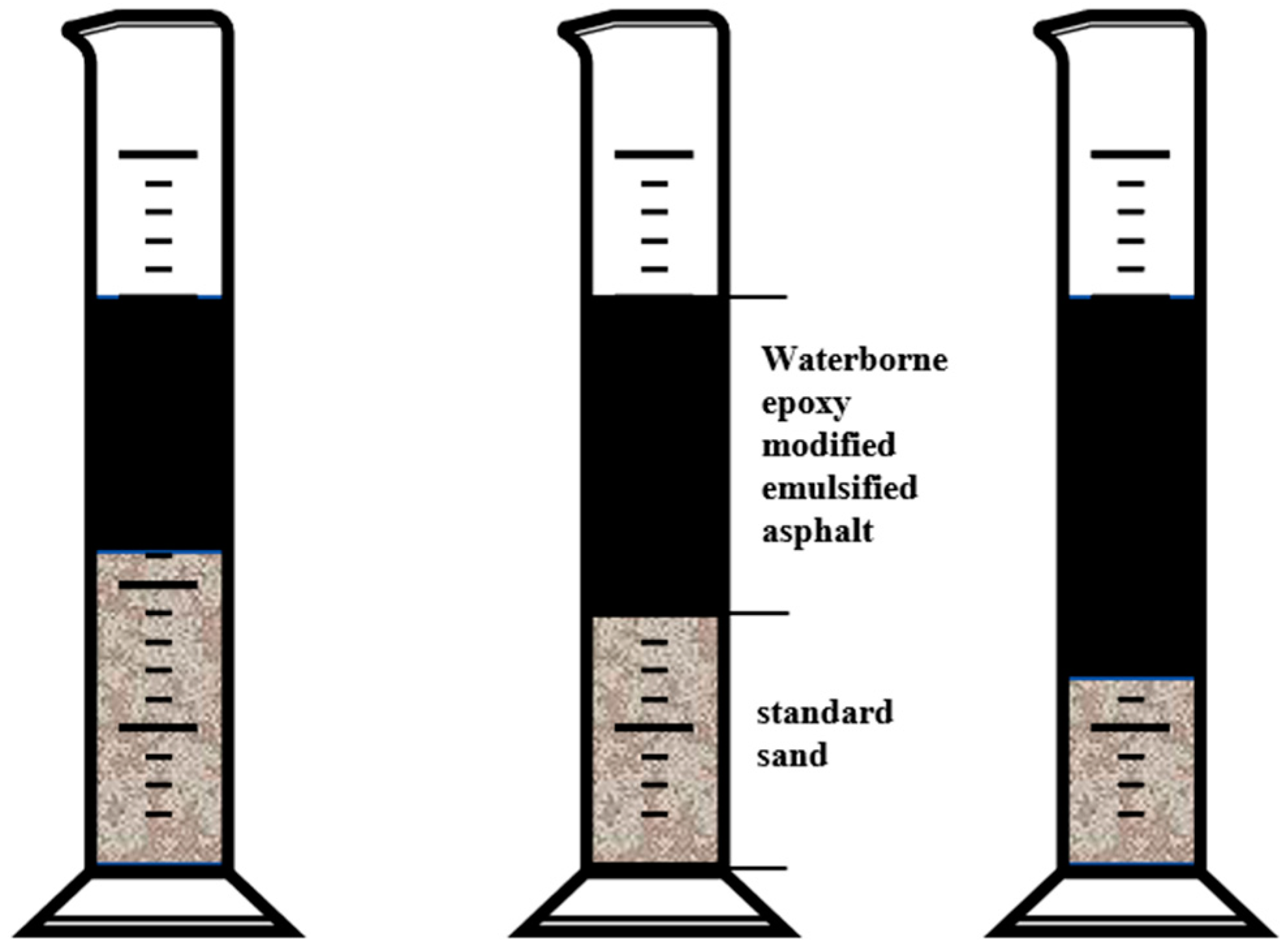
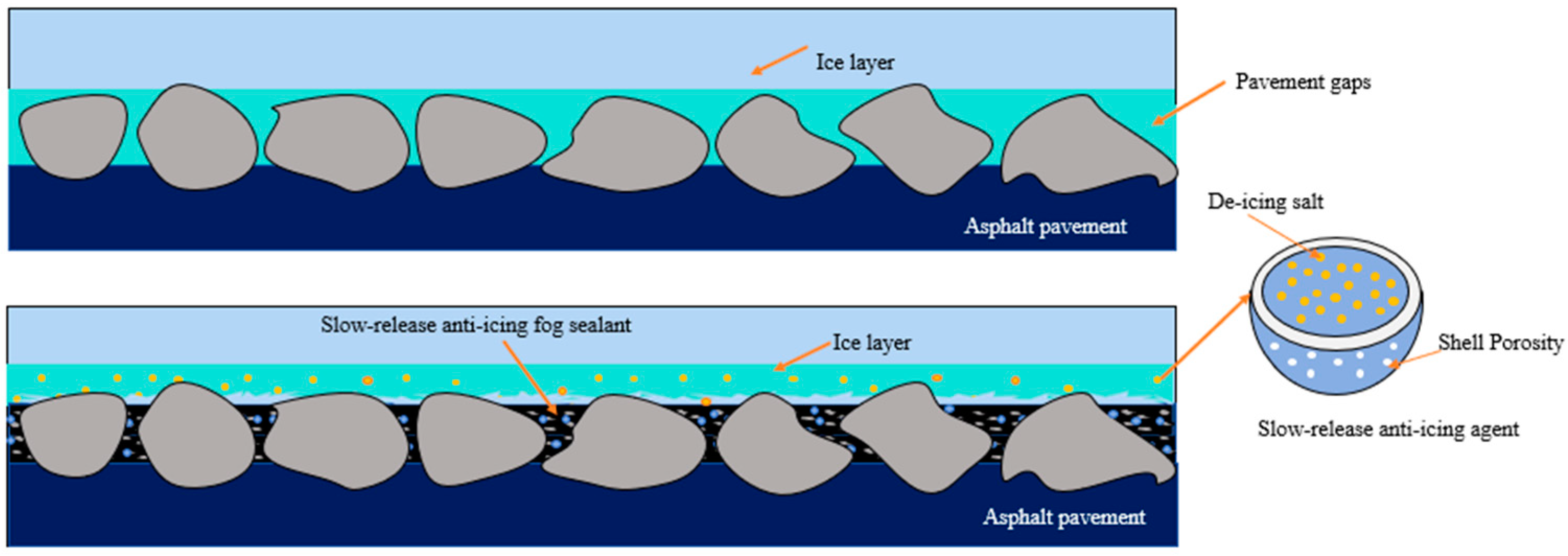

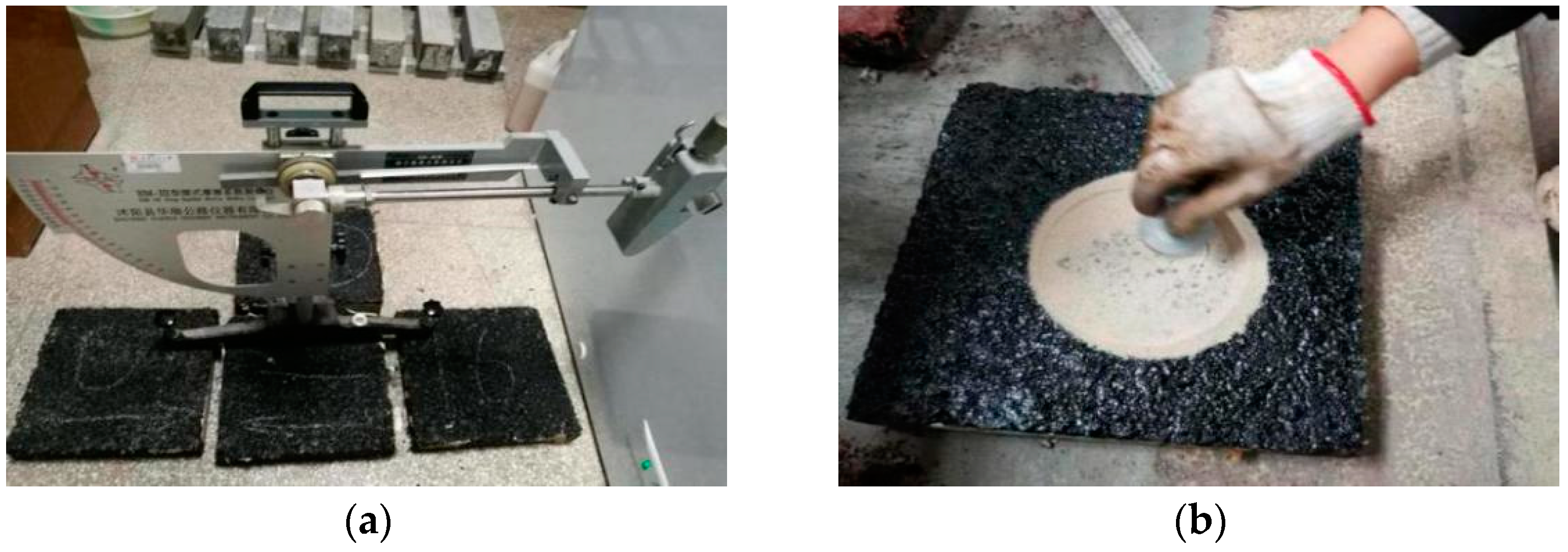
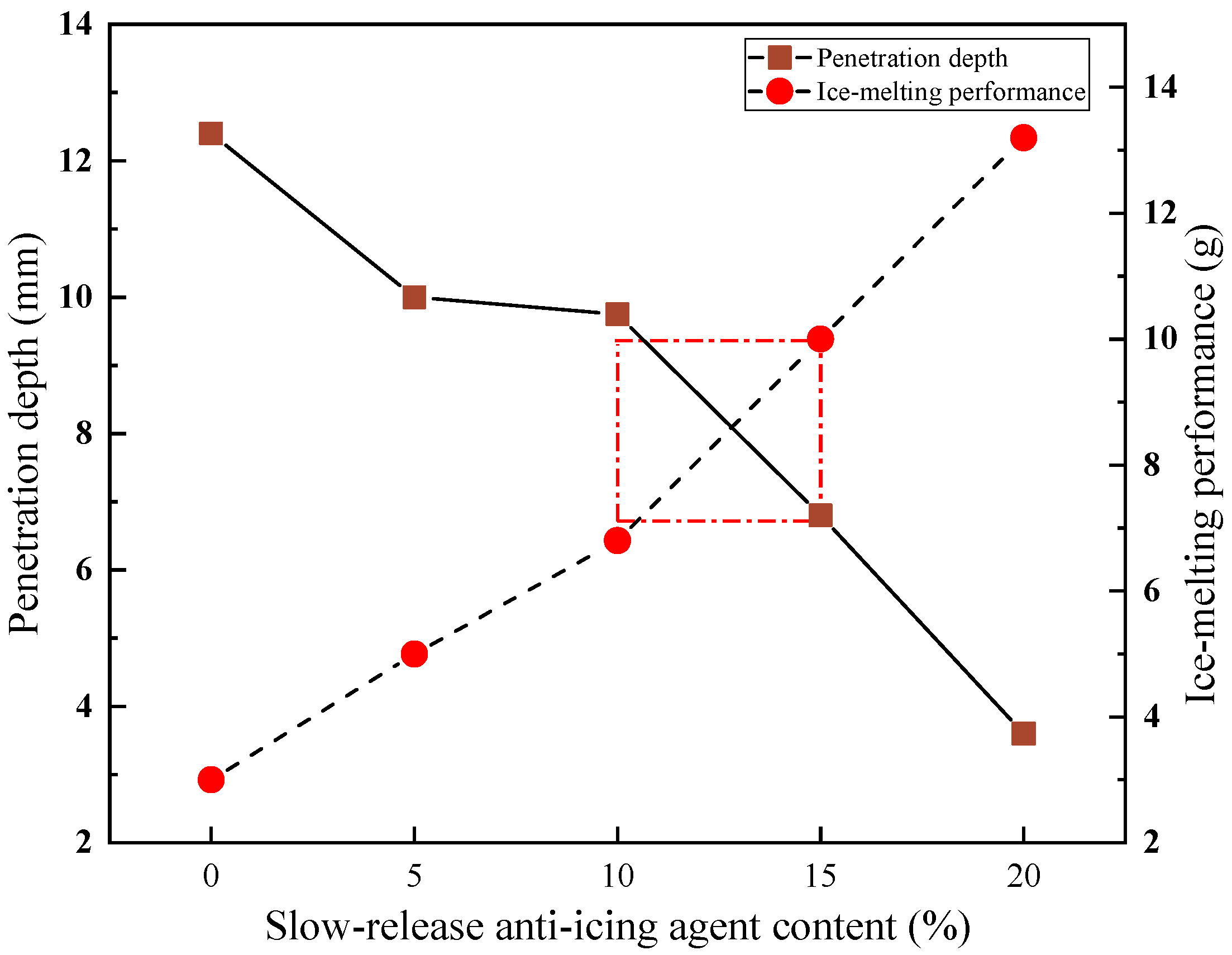
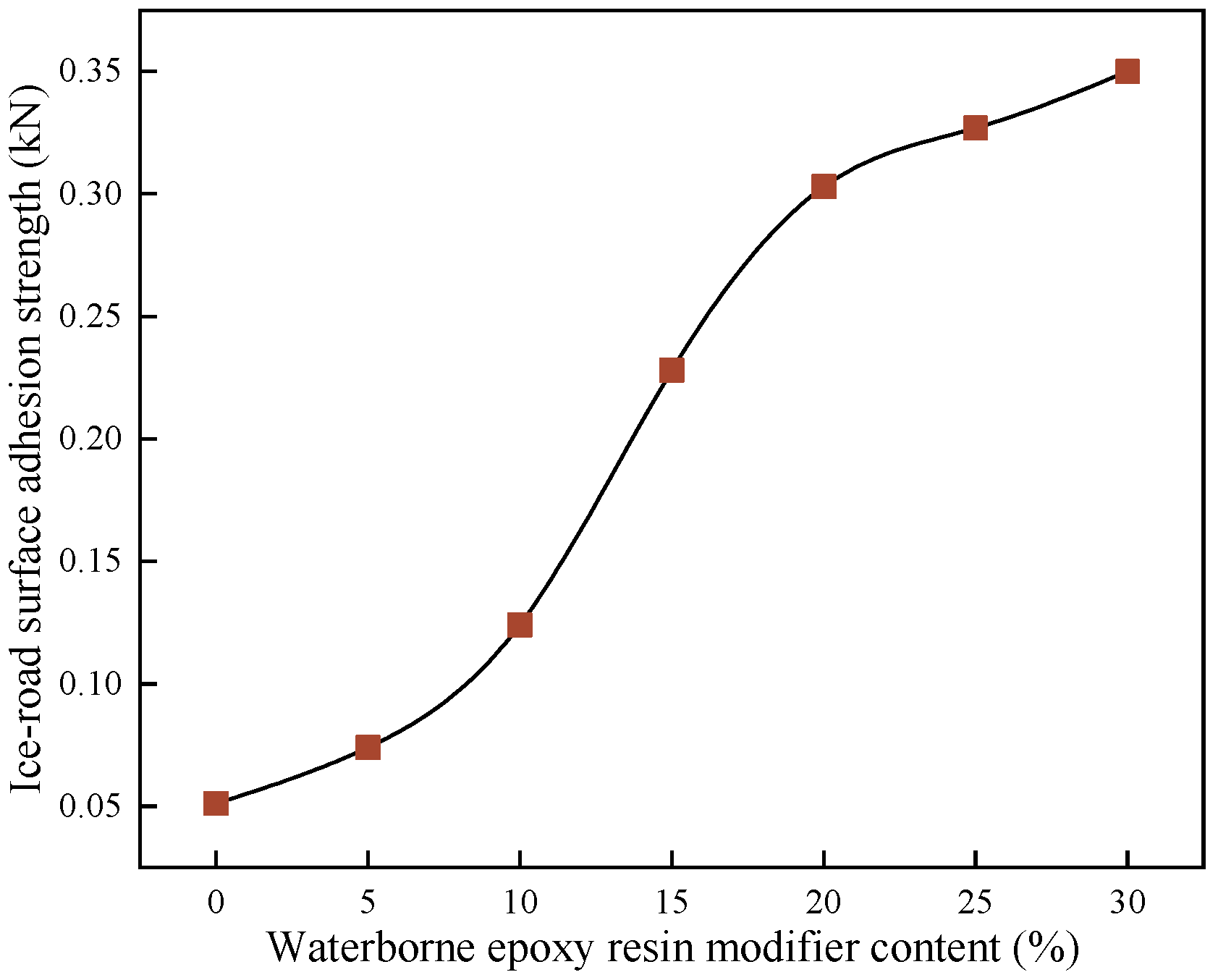



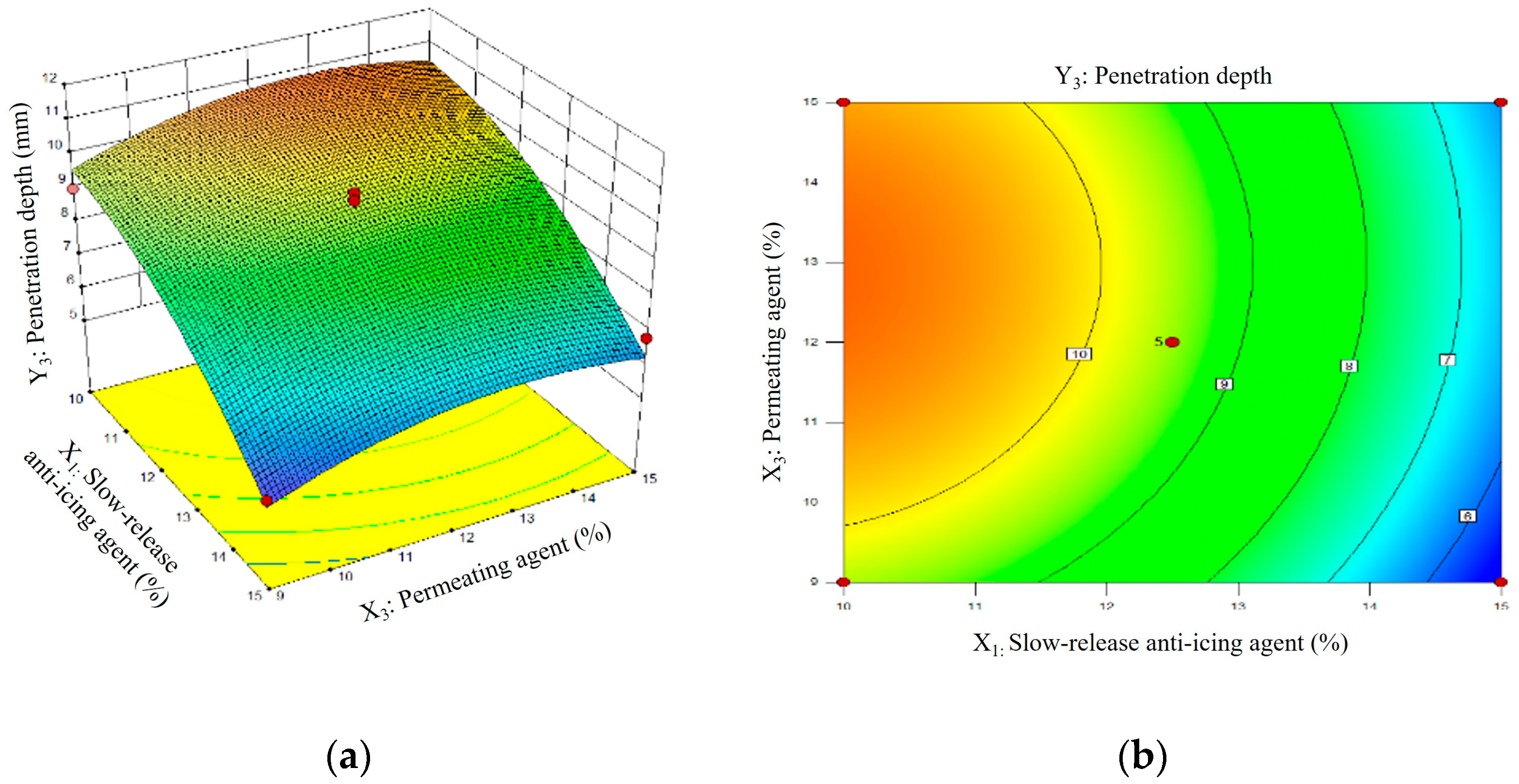
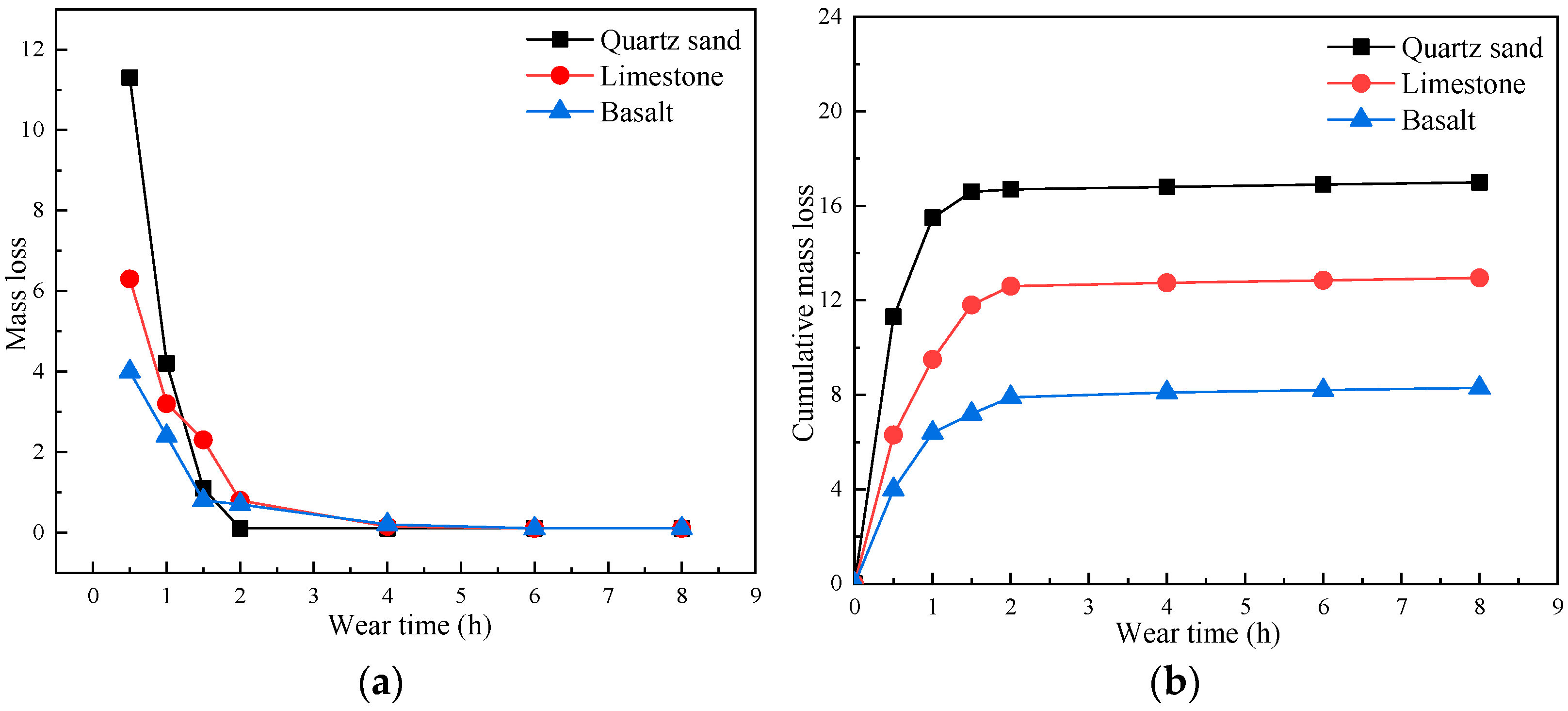
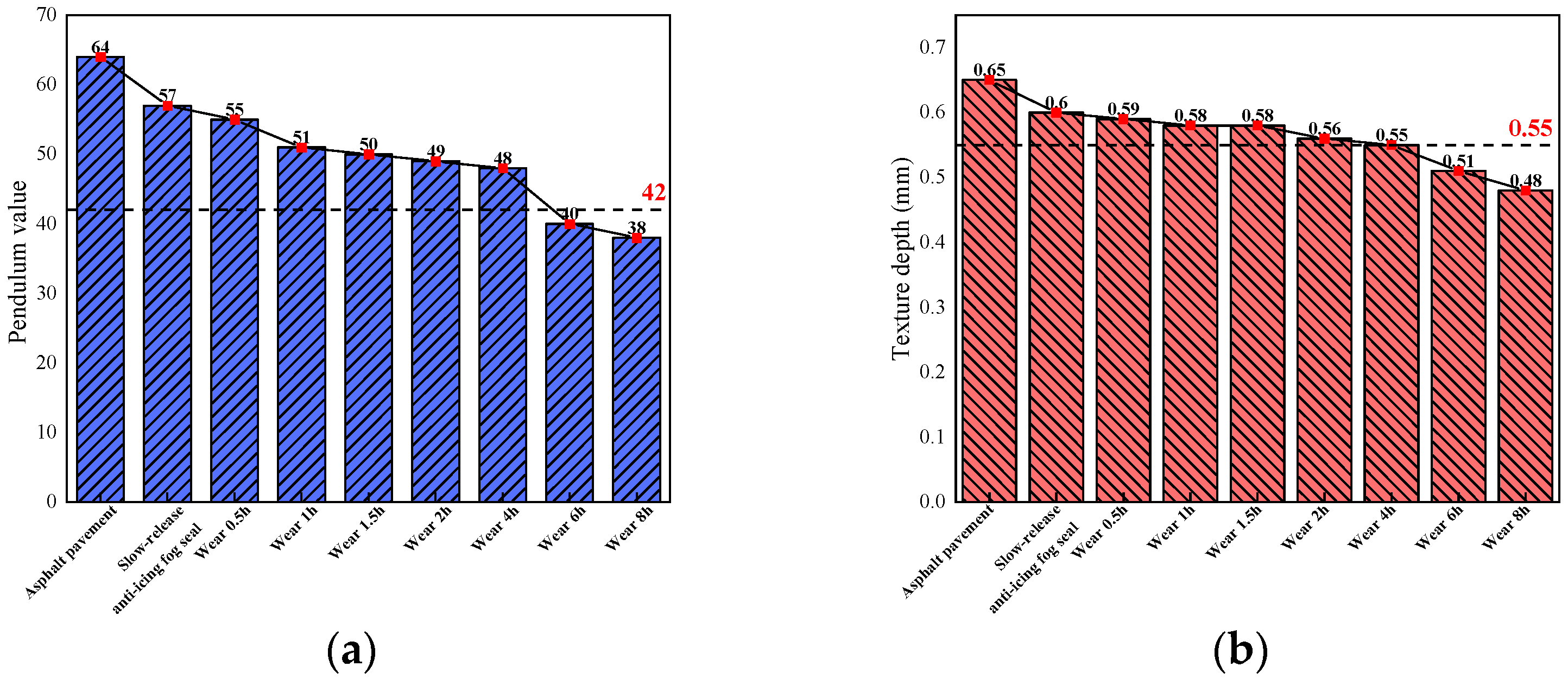
| Test Items | Quality Indicators | Test Result |
|---|---|---|
| Demulsification rate | Quick cracking or medium cracking | Quick cracking |
| Particle charge | Cationic | Cationic |
| Residue on sieve (1.18 mm sieve/%) | ≥0.1 | 0.11 |
| Engler viscosity (E2s) | 1~6 | 4.3 |
| Storage stability at room temperature (1 day/%) | ≤1 | 0.6 |
| Test Items | Test Result |
|---|---|
| Solid content (%) | 50 |
| pH value | 7~8 |
| Epoxy value (Equivalent/100 g) | 0.23 |
| Storage stability (180 days) | No Stratification |
| Centrifugal stability (3000 r/min, 30 min) | No Stratification |
| Test Items | Test Result |
|---|---|
| Appearance | Light yellow uniform fluid |
| Solid content (%) | 50 ± 2 |
| ph | 7~10 |
| Active hydrogen equivalent (solid content) | 210 ± 30 |
| Viscosity (mpa·s/25 °C) | 4000–7000 |
| Specific gravity | 1.02–1.09 |
| Test Items | Unit | Standard Value | Test Result |
|---|---|---|---|
| Appearance | - | - | White powder |
| Chloride ion content | % | ≥40 | 46.25 |
| Relative density | - | ≥1.7 | 2.276 |
| Salt release amount | % | ≤0.4 | 0.1 |
| Freezing point | °C | ≤−5 | −10 |
| Ice melting rate | % | ≥20 | 25.6 |
| Moisture content | % | ≤1 | 0.51 |
| Type | Component | Acidity or Alkalinity | Density (g/cm3) | Mohs Hardness |
|---|---|---|---|---|
| Quartz sand | SiO2 (≥90%) | Acidic | 2.65 | 7 |
| Limestone | CaCO3 | Alkaline | 2.70 | 3 |
| Basalt | SiO2 (≤50%), Al2O3, CaO, etc. | Alkaline | 2.83 | 6 |
| Variable Factors | Number | Level (%) | ||
|---|---|---|---|---|
| 1 | 2 | 3 | ||
| Slow-release anti-icing agent | X1 | 10 | 12.5 | 15 |
| Waterborne epoxy resin modifier | X2 | 10 | 15 | 20 |
| Permeating agent | X3 | 9 | 12 | 15 |
| Number | X1/% | X2/% | X3/% | Y1/g | Y2/KN | Y3/mm |
|---|---|---|---|---|---|---|
| 1 | 12.5 | 20 | 15 | 15.68 | 0.334 | 8.39 |
| 2 | 10 | 15 | 9 | 12.73 | 0.276 | 9.01 |
| 3 | 15 | 10 | 12 | 17.27 | 0.103 | 5.98 |
| 4 | 12.5 | 15 | 12 | 15.19 | 0.215 | 9.17 |
| 5 | 12.5 | 20 | 9 | 15.61 | 0.347 | 7.98 |
| 6 | 12.5 | 10 | 9 | 14.78 | 0.134 | 8.39 |
| 7 | 15 | 15 | 15 | 18.15 | 0.187 | 6.79 |
| 8 | 10 | 20 | 12 | 12.98 | 0.359 | 10.39 |
| 9 | 10 | 10 | 12 | 11.8 | 0.171 | 11.44 |
| 10 | 15 | 15 | 9 | 18.44 | 0.199 | 5.33 |
| 11 | 12.5 | 15 | 12 | 14.23 | 0.206 | 9.29 |
| 12 | 15 | 20 | 12 | 18.36 | 0.318 | 5.67 |
| 13 | 10 | 15 | 15 | 12.33 | 0.223 | 10.27 |
| 14 | 12.5 | 15 | 12 | 13.96 | 0.215 | 9.68 |
| 15 | 12.5 | 15 | 12 | 14.77 | 0.214 | 9.91 |
| 16 | 12.5 | 15 | 12 | 15.27 | 0.217 | 9.44 |
| 17 | 12.5 | 10 | 15 | 15.08 | 0.121 | 9.18 |
Disclaimer/Publisher’s Note: The statements, opinions and data contained in all publications are solely those of the individual author(s) and contributor(s) and not of MDPI and/or the editor(s). MDPI and/or the editor(s) disclaim responsibility for any injury to people or property resulting from any ideas, methods, instructions or products referred to in the content. |
© 2025 by the authors. Licensee MDPI, Basel, Switzerland. This article is an open access article distributed under the terms and conditions of the Creative Commons Attribution (CC BY) license (https://creativecommons.org/licenses/by/4.0/).
Share and Cite
Meng, J.; Wei, L.; Guo, P. Development and Performance Study of a Slow-Releasing Anti-Icing Fog Seal Based on Response Surface Methodology. Coatings 2025, 15, 318. https://doi.org/10.3390/coatings15030318
Meng J, Wei L, Guo P. Development and Performance Study of a Slow-Releasing Anti-Icing Fog Seal Based on Response Surface Methodology. Coatings. 2025; 15(3):318. https://doi.org/10.3390/coatings15030318
Chicago/Turabian StyleMeng, Jianwei, Lin Wei, and Peng Guo. 2025. "Development and Performance Study of a Slow-Releasing Anti-Icing Fog Seal Based on Response Surface Methodology" Coatings 15, no. 3: 318. https://doi.org/10.3390/coatings15030318
APA StyleMeng, J., Wei, L., & Guo, P. (2025). Development and Performance Study of a Slow-Releasing Anti-Icing Fog Seal Based on Response Surface Methodology. Coatings, 15(3), 318. https://doi.org/10.3390/coatings15030318






